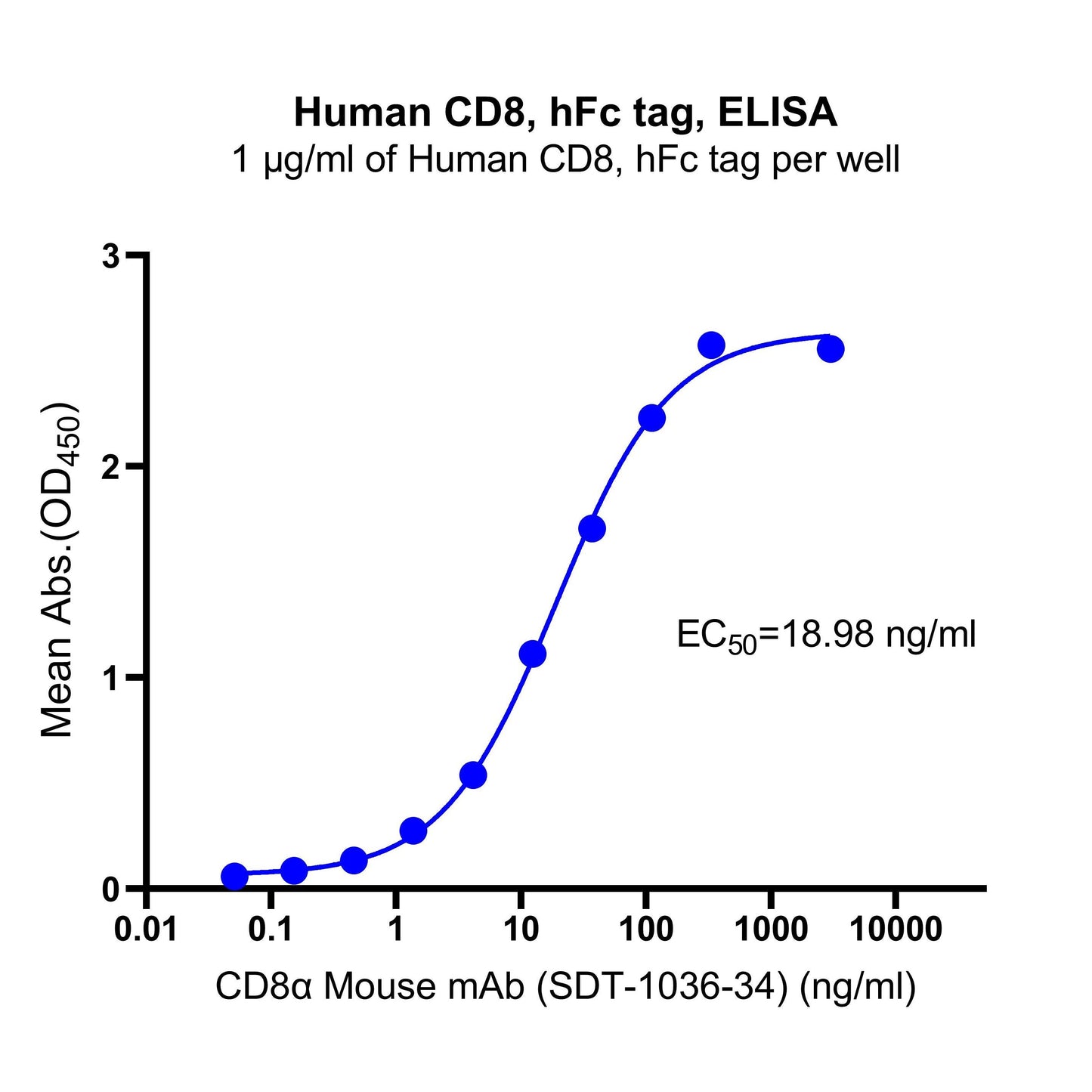Immobilized Human CD8, hFc tag at 1 μg/mL (50 μL/well) can bind CD8α Mouse mAb (SDT-1036-34) (Cat. No. S0B2307) with EC50 of 15.68-23.01 ng/ml.
Product Details
Product Details
Product Specification
| Species | Human |
| Synonyms | T-lymphocyte differentiation antigen T8/Leu-2, MAL |
| Accession | P01732 |
| Amino Acid Sequence | Protein sequence (P01732, Ser22-Asp182, with C-hFc) SQFRVSPLDRTWNLGETVELKCQVLLSNPTSGCSWLFQPRGAAASPTFLLYLSQNKPKAAEGLDTQRFSGKRLGDTFVLTLSDFRRENEGYYFCSALSNSIMYFSHFVPVFLPAKPTTTPAPRPPTPAPTIASQPLSLRPEACRPAAGGAVHTRGLDFACDEPKSCDKTHTCPPCPAPELLGGPSVFLFPPKPKDTLMISRTPEVTCVVVDVSHEDPEVKFNWYVDGVEVHNAKTKPREEQYNSTYRVVSVLTVLHQDWLNGKEYKCKVSNKALPAPIEKTISKAKGQPREPQVYTLPPSRDELTKNQVSLTCLVKGFYPSDIAVEWESNGQPENNYKTTPPVLDSDGSFFLYSKLTVDKSRWQQGNVFSCSVMHEALHNHYTQKSLSLSPGK |
| Expression System | HEK293 |
| Molecular Weight | Predicted MW: 43.7 kDa Observed MW: 55 kDa |
| Purity | >95% by SDS-PAGE |
| Tag | with C-hFc |
| Physical Appearance | Lyophilized Powder |
| Storage Buffer | Lyophilized from a 0.2 μm filtered solution of 0.2M PBS, pH7.4. |
| Reconstitution | Reconstitute no more than 1 mg/mL according to the size in deionized water after rapid centrifugation. |
| Stability & Storage | 12 months from date of receipt, -20 to -70 °C as supplied. 6 months, -20 to -70 °C under sterile conditions after reconstitution. 1 week, 2 to 8 °C under sterile conditions after reconstitution. Please avoid repeated freeze-thaw cycles. |
Background
CD8 (cluster of differentiation 8) is a transmembrane glycoprotein that serves as a co-receptor for the T-cell receptor (TCR). Along with the TCR, the CD8 co-receptor plays a role in T cell signaling and aiding with cytotoxic T cell-antigen interactions. Like the TCR, CD8 binds to a major histocompatibility complex (MHC) molecule, but is specific for the MHC class I protein. There are two isoforms of the protein, alpha and beta. The extracellular IgV-like domain of CD8-α interacts with the α3 portion of the Class I MHC molecule. Cytotoxic T cells with CD8 surface protein are called CD8+ T cells. Once the T cell receptor binds its specific antigen Lck phosphorylates the cytoplasmic CD3 and ζ-chains of the TCR complex which initiates a cascade of phosphorylation eventually leading to activation of transcription factors like NFAT, NF-κB, and AP-1 which affect the expression of certain genes.
Picture
Picture
Bioactivity
SDS-PAGE
2μg(R: reducing conditions)


